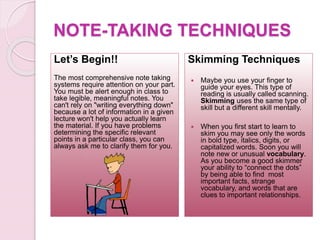
Note-Taking Techniques
- 1. NOTE-TAKING TECHNIQUES Let’s Begin!! The most comprehensive note taking systems require attention on your part. You must be alert enough in class to take legible, meaningful notes. You can't rely on "writing everything down" because a lot of information in a given lecture won't help you actually learn the material. If you have problems determining the specific relevant points in a particular class, you can always ask me to clarify them for you. Skimming Techniques Maybe you use your finger to guide your eyes. This type of reading is usually called scanning. Skimming uses the same type of skill but a different skill mentally. When you first start to learn to skim you may see only the words in bold type, italics, digits, or capitalized words. Soon you will note new or unusual vocabulary. As you become a good skimmer your ability to “connect the dots” by being able to find most important facts, strange vocabulary, and words that are clues to important relationships.
- 2. NOTE-TAKING TECHNIQUES Secrets to Taking Better Notes There is no magic to taking good notes, just common sense. It's simply a matter of being thorough and accurate. Now, not many people can write fast enough to capture everything their teacher says in class. Pay attention and listen carefully that way you won't miss something while you write, and you can double-check for accuracy. Reviewing your notes as soon as possible while the subject is still fresh in your mind is the key to success. Read your notes on a daily basis during breaks, while waiting for the bus, when you have completed an assignment in class early. By re-writing your notes, you become more familiar with the material. You mentally reinforce what was said in class, and you get practice writing the information, making it easier to write the material a second time on a test.
- 3. NOTE-TAKING TECHNIQUES Attend Class The most important advice I can give to you is to make sure you attend your classes. Attendance in class enhances the chance you'll get a passing grade in a course. In addition to attending class, it is important to brush up on your note-taking skills to really achieve optimum success. Some general recommendations for improving note-taking skills are listed to the right: 1. Read the chapter prior to attending class. 2. Make sure you take notes in class. If you fail to take notes, much of what you learn from the lecture will be forgotten in a few days. If you have something written down on paper, you can always refer to the material later. 3. Ask teachers who lecture too fast if they can slow down. You'll generally find that many teachers are willing to assist you in your efforts to gain as much from their lecture as possible.
- 4. NOTE-TAKING TECHNIQUES The Cornell Method of Note-Taking: Make two columns, using the red line on the left of the page as your border. Then, when you take notes in class, use the 6 column for the notes and the smaller 2 column on the left as a highlighting system. Write main headings and important points on the left, including material you think you will be tested. When you're finished, you should have a comprehensive page of information that you can quickly scan for important points. Studying is 99% perspiration; if you give it a real, strong effort over year you will see an improvement. Your academic success is entirely up to you.
- 5. NOTE-TAKING TECHNIQUES 2 1/2” -------------- ------- Cue Column 6” --------------------------------------------------------------------------------------- Note-taking Column 1. Record: During the lecture, use the note-taking column to record the lecture using telegraphic sentences. 1. Questions: As soon after class as possible, formulate questions based on the notes in the right-hand column. Writing questions helps to clarify meanings, reveal relationships, establish continuity, and strengthen memory. Also, the writing of questions sets up a perfect stage for exam-studying later. 1. Recite: Cover the note-taking column with a sheet of paper. Then, looking at the questions or cue-words in the question and cue column only, say aloud, in your own words, the answers to the questions, facts, or ideas indicated by the cue-words. 1. Reflect: Reflect on the material by asking yourself questions, for example: “What’s the significance of these facts? What principle are they based on? How can I apply them? How do they fit in with what I already know? What’s beyond them? 5. Review: Spend at least ten minutes every week reviewing all your previous notes. If you do, you’ll retain a great deal for current use, as well as, for the exam. ---------------- 2” Summary After class, use this space at the bottom of each page to summarize the notes on that page.
- 6. NOTE-TAKING TECHNIQUES Key Note-Taking Column Tips Record: During the lecture, use the note-taking column to record the lecture using telegraphic sentences. Questions: As soon after class as possible, formulate questions based on the notes in the right-hand column. Writing questions helps to clarify meanings, reveal relationships, establish continuity, and strengthen memory. Also, the writing of questions sets up a perfect stage for exam-studying later. Recite: Cover the note-taking column with a sheet of paper. Then, looking at the questions or cue-words in the question and cue column only, say aloud, in your own words, the answers to the questions, facts, or ideas indicated by the cue-words. Reflect: Reflect on the material by asking yourself questions, for example: “What’s the significance of these facts? What principle are they based on? How can I apply them? How do they fit in with what I already know? What’s beyond them? Review: Spend at least ten minutes every week reviewing all your previous notes. If you do, you’ll retain a great deal for current use, as well as, for the exam. www.academictips.org/acad/literature/notetaking.html
